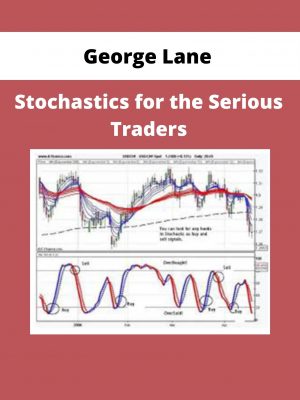Dave Landry – Trading High-Momentum Stocks With Landry Persistent Pullbacks
$36
Shopping Instructions:
- DISCOUNT 15% : SHOP15
- Product Delivery: Within 1 – 12 hours after purchase.
Through 30 bar-by-bar trading simulations that I have created and designed myself, I will walk you through actual trading setups. You will be 100% responsible for making your own real world trading decisions to “BUY,” “SELL,” or “DO NOTHING.”
Dave Landry – Trading High-Momentum Stocks With Landry Persistent PullbacksProduct DescriptionIf I Could Trade Only One Strategy In The World…This Would Be It! Introducing Dave Landry’s Best Method For Daytraders and Swing Traders…Persistent PullbacksWould you like to…
During the 12 years that I have tested and traded (and discarded) many different trading strategies, I have found only one approach is both consistent and effective: Pullbacks. And while there are many pullback strategies that have been published, only one stands out as being the very best. Based upon my research, testing and trading experience, there is no pullback strategy that is as reliable as the Persistent Pullback Strategy. In my new training module, “Trading High-Momentum Stocks With Landry Persistent Pullbacks,” I will teach you this strategy. You will learn all the basics of how to quickly find these special pullback setups. Then, I will teach you how to trade them by training you bar-by-bar through over 30 trading simulations. Here’s an example of the kinds of high momentum gainers you can find and trade with the Persistent Pullback Strategy 1. Ryland Group (RYL) is locked into a strong uptrend. And you can do the same on the short side… 1. Lockheed Martin (LMT) is locked into a strong downtrend. What Are Persistent Pullbacks And What Makes Them Better Than Any Other Pullback Strategy? Conventional pullbacks tend to have spotty performance. That is, they work reliably and identify profitable entries into strong trends for a period of time. But then, they go though bad periods in which they get stopped repeatedly right after entry. Not good. The solution to this is the Persistent Pullback Strategy. At first glance, Persistent Pullbacks follow a familiar routine. You have a strong trend followed by a brief correction. Once the correction has ended, you enter a trade and the trend resumes. But there is one huge difference. There is a distinct and well-defined pattern that actually comes right before a Persistent Pullback. And it is this pattern that makes all the difference in the world. This pattern, which I teach you in my module, tells you that a stock is “locked into” a trend. It suggests that the trend is so persistent that it has become the norm. Any pullback that occurs will tend to revert to that norm. Does it work 100% of the time? No. But ever since I developed The Persistent Pullback Strategy over three years ago, I have continued to witness over and over again its strength and consistency as I identify powerful moves in stocks over and over again through some of the most challenging markets we’ve seen in the recent years. And one of the best aspects of this is that it automatically adapts itself to any market environment. Put simply, the Persistent Pullback Strategy works when there are strong trends. When the market turns choppy, the Persistent Pullback Strategy will simply keep you out of bad trades. Over time, I have not found any other way to identify the strongest pullback setups that comes close to the Persistent Pullback Strategy. Not ADX. Not momentum oscillators. Not even my big blue “trend-following moron” arrows. Here Is What You Will Learn In My Interactive Training Module My Persistent Pullback Strategy is a complete and self-contained trading strategy. I will teach you how to apply it to your own trading in four sections: In Section I, I’ll start you off by teaching the basics of Swing Trading. This is an important foundation for us to build on if you are going to get the most out of my teaching later on in the course. You will learn: * How to capture the “sweet spot” of market movement—large percentage moves that occur over 2 to 7 days. In Section II, I will teach you my 5 rules of identifying and trading Persistent Pullbacks. You will learn: * The basic logic of pullbacks and the inherent limitations of standard pullback strategies and how you can overcome them using my Persistent Pullbacks. In Section III, I will walk you through numerous real world examples so that you will be fully prepared to apply Persistent Pullbacks to your own trading. Through these examples you will: * Gain proficiency in trading both the long and short side of the market using Persistent Pullbacks. Download immediately Dave Landry – Trading High-Momentum Stocks With Landry Persistent Pullbacks Finally, in Section IV, I will put you in the hot seat. This is where you will learn how to master the application of Persistent Pullbacks to your own trading. Through 30 bar-by-bar trading simulations that I have created and designed myself, I will walk you through actual trading setups. You will be 100% responsible for making your own real world trading decisions to “BUY,” “SELL,” or “DO NOTHING.” My goal is to get you to the point where you are trading Persistent Pullbacks with perfect execution. To do that , I will be by your side with every decision you make, prompting you, correcting you and teaching you, whether you blow it or make the right choices. When you make a mistake, I will make sure that you learn from it by explaining my thought process that leads to the correct decision. These simulations are no holds barred. You will experience both easy situations and more challenging ones in which unexpected things happen. But I fully expect that as you go through the simulations, you will learn to make fewer and fewer mistakes. My goal is that by the time you finish all the simulations, you will be executing the strategy perfectly and will be ready to apply my Persistent Pullback Strategy to your own trading. I will provide you with the most intensive and thorough training available for learning the Persistent Pullback Strategy, through my bar-by-bar simulations. In each simulation, we will walk through actual trading setups and I will expose you to real world trading decisions. Stock trading course: Learn about Stock trading A stock trader or equity trader or share trader is a person or company involved in trading equity securities. Stock traders can trade on their own account, called proprietary trading, or through an agent authorized to buy and sell on the owner’s behalf. Major stock exchanges have market makers who help limit price variation (volatility) by buying and selling a particular company’s shares on their own behalf and also on behalf of other clients. |
Related products
Forex & Trading
Forex & Trading
Forex & Trading
Forex & Trading
Forex & Trading
Forex & Trading
Forex & Trading












